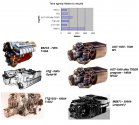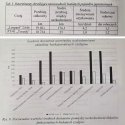The 1st Guards Tank Army did not collapse. They had some tank losses but they have like 500-800 tanks.
At most I have seen like half a dozen broken down T-80U tanks from the 4th Guards Tank Division since the war started. And those guys alone have almost 200 T-80U tanks. Even if you believed Oryx's numbers of 80 T-80U losses that would be less than half the T-80U tanks just one of the Divisions has, not the whole Army.
It doesn't matter if Russia still has plenty of tanks if it can't use it in combat.
Combat losses are not the main factor in determining whether a formation is
neutralized. Losses to mechanical wear and failure are more important over time. Past the first 1-2 months of fighting the number of vehicles are in combat readiness is the actual benchmark of losses. A tank that doesn't move is like an aircraft that doesn't fly. An aircraft that can't fly is inactive and therefore neutralized.
Russian army uses the same equipment as the Soviet army. That has consequences.
USSR built its doctrine around the assumption that the strategic conflict with US/NATO would be resolved in Europe. They assumed that the Rhine would be reached in 14 days as Germany had depth of only 250-350km, after which the Netherlands would be captured and France would be forced into separatist peace. The UK would be bombed until it surrendered and US would be cut from natural entry points while the dollar system was being collapsed by removal of European economies. We know it from declassified war plans of the Warsaw Pact.
Because USSR attempted to maximize its conventional advantage over NATO it developed a very asymmetric and inflexible response building on the strategic solutions from WW2 but with self-sustainability in mind. USSR designed tanks with ease of manufacture and training in mind - at the cost of quality, reliability. The tanks were designed with limited service life of components and very high failure rate (partly because it was forced to by limitations of Soviet industry) because they were intended for mass use and in NBC conditions. In Soviet doctrine if a tank or a gun broke down it was abandoned as the main objective was to maintain the tempo of assault. Similarly if units were to withdraw they were allowed to abandon equipment. Because of the time constraints that were imposed by strategy losses did not matter and they were balanced by greater numbers of available vehicles and mobilized echelons - approaching double of NATO levels.
On a tactical level there was also a difference - Soviet units were meant to achieve operational objectives while NATO units were meant to delay the advance and destroy as much of enemy potential as possible.
Russia uses the same equipment and (I would argue) the same fundamental doctrine but in completely different conditions. The conflict so far has lasted six months with no clear resolution in sight. The infrastructure is non-existent so any operation of the vehicles is more taxing. The maintenance and logistical support is the same as in 1980s European theater. Russian army is the Soviet army for a month-long war in Western Europe but Russia used it for a six-months-long war in Eastern Europe.
Here are some examples of what I'm talking about:
Comparison of time to rebuild for select tank engines

Note also that MB873 is installed as a power-pack with integrated transmission which is another high-wear element. Replacement of Leopard 2 power-pack takes a maximum of 2 hours.
V92 (T-90, T-72B3) and V84 (T-72B) which are a development of V45 are not a power-pack with the exception of last versions of the tanks. They are very but cheap to manufacture but extremely time-consuming and difficult to maintain. On a regular basis the T-72 tanks in Polish service required as much as 24 hour period for complete maintenance of the engine and transmission.
Comparison of mean time between failure and other performance for Leopard 2A4 and PT-91 (Polish T-72M modification)

The table columns are: (1) tank, (2) total distance, (3) mean distance between failures, (4) mean daily use, (5) mean time to rebuild
The graph lists mean distance between failures of component - columns, left to right: (1) chassis, (2) engine, (3) trasmission, brakes, hydraulics, (4) vehicle steering, (5) electrical installation, (6) armament, (7) fire control, (8) steering - turret and weapon systems, (9) communication, (10) special systems - fire suppression, NBC etc.
We also have to remember that:
Leopard 2 and PT-91 used different standards for maintenance - Leopard 2 per Heer standards, PT-91 per Warsaw Pact standards - which also influenced the results. Leopard 2 was also the extreme example of design optimization where preservation of a functional vehicle was a priority, more so than with M1. Germany army needed tanks and other vehicles at constant readiness hence the high performance.
The consequences for Ukraine are that T-72s and T-80s are being used constantly and
machine wear occurs at a much higher rate than was intended in intended combat conditions i.e. 14-30-day campaign in Western Europe. Consider things like lack of auxiliary power units which require old tank engines to run whenever any system of the tank is operated. Consider lack of good roads in Ukraine. Consider lack of sufficient maintenance personnel since Russian logistical system is completely not designed for prolonged warfare. All of that has lasted for
six months of intense fighting.
Similar considerations apply to other vehicles which were all designed and manufactured according to the same rules. Because Russia utilizes vast stocks from Soviet era it has only a handful of new, more efficient designs and
almost none of them are free of western mechanical components which means other vehicles have to be cannibalized due to sanctions.
Ukraine has the same technical problems but it is in a completely different strategic position. From the beginning it knew it couldn't afford to lose anything, while Russia never expected to lose anything. So even though the losses for both sides are comparable relative to the stocks, there is a serious issue of availability due to how the losses are processed.
Hence if 1st Tank Army cant field a division due to lack of working vehicles it is classified as
neutralized and that is the term that the military will use. Obviously the propaganda will describe it as "destroyed" even though it makes no sense as any unit can be reformed because it's an administrative designation.
Also - summary from Oryx dated 14 september:

If we assume 1 vehicle lost to wear and damage per 1 vehicles lost in combat that changes the statistics significantly. Then if we include the requirement of combat units to operate in tactical formations it becomes obvious why a tank regiment consisting of nine companies is not fielded if there is less than two companies of working tanks despite losses only amounting to two companies with seven companies remaining. Such unit will be withdrawn from combat to prevent physical destruction. Such withdrawal will be likely presented by propaganda as "destruction" even though the unit can be restored to readiness. How long it will take is an entirely different question.



